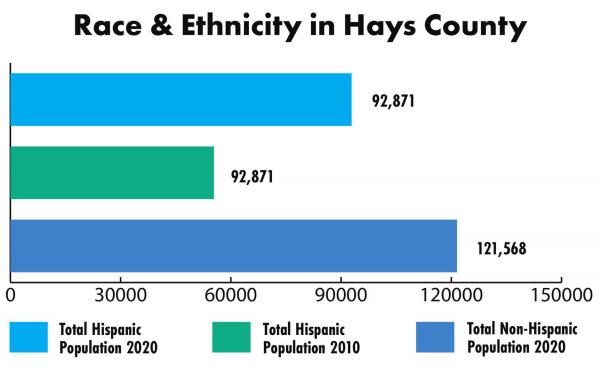Demographic changes minimal in Dripping Springs
While other cities in Hays County are growing more racially and ethnically diverse, Dripping Springs is moving only slowly, if at all, in that direction.
Due to the spotty nature of the Dripping Springs city limits, it isn’t a perfect representation of the entire community, but data released by the U.S. Census Bureau show that Dripping Springs might have actually become less diverse over the last 10 years while Hays County as a whole is exactly the opposite.
The inflow of Hispanics into Dripping Springs is significant, but due to larger numbers of Whites coming into the area, the overall percentage of Hispancis in the local population fell from 2010 to 2020. And the number of people identifying as Black remains tiny. However, there was an increase in people who self-identified racially as Other as well as a noticeable, yet small, increase of Asians.
Those facts emerge from new Census Bureau population headcount data released last month. The count was conducted across the United States in 2020 as required by federal law.
Here’s what the numbers show:
• Whites accounted for 68.2 percent of the Dripping Springs population in 2010. In 2020, they made up 72 percent. There were 3,346 Whites in 2020, up from 1,220 in 2010.
• Hispanics accounted for 29 percent of the Dripping Springs population in 2010. In 2020, they made up 21.3 percent of the total. There were 989 Hispanics in 2020, up from 521 in 2010.
• Others accounted for 2 percent of the population in 2010 and 4.6 percent in 2020. The Asian population was not identified in 2010 by the numbers currently shown on the state of Texas demographic website but was 1.2 percent in 2020, which was 54 in total. In 2010 Blacks represented .7 percent of Dripping Springs. That total increased from 12 in 2010 to 47 total in 2020 raising the percentage of the population to 1.0 percent.
For context, the state of Texas has as many Hispanics as Non White Hispanics. An influx of Hispanics between 2010 and 2020 drove an overall population increase in the state, according to data compiled by the Texas Demographic Center.
In Hays County, Hispanics made up 35 percent of the population in 2010 and 38.5 percent in 2020. Hays County, which is growing at the fastest clip of any county in the nation, was 85 percent Non Hispanic White in 1990.
Hispanics are moving into the county, said Dr. Sherri Mora, professor of political science at Texas State University.
“They are coming from other states,” she said, mainly California, Florida and Illinois.
“It seems most of the Hispanic growth is in San Marcos and east of the (Interstate 35) area,” said Mary Espinoza, who is active in Hays County politics. She knows firsthand about the in-migration of Hispanics east of I-35 and in the county seat because she has walked those blocks and talked with residents in person. “Hispanics are moving into these areas for housing and jobs. Easy access to I-35 for jobs in Austin, San Marcos and surrounding cities is a driving factor for Hispanic in-migration in those areas. Land seems to be less expensive and more plentiful east of I-35.”
On the other hand, land prices in Dripping Springs are expensive and are less affordable.
“What happens here is what happens elsewhere,” Kotarba said. “You live where you can afford to live.”
Mora said other reasons Hispanics are drawn to this region have to do with cultural commonalities with people who already live here.
In other words, the presence or absence of Hispanics may set the stage for future in-migration of more Hispanics in this county and in the cities within the county.
“My general observation is that people get along extremely well in the Hill Country,” Kotarba said.


